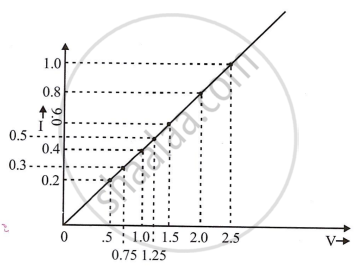Advertisements
Advertisements
Question
In an experiment of verification of Ohm’s law following observations are obtained.
|
Potential difference V (in volt) |
0.5 | 1.0 | 1.5 | 2.0 | 2.5 |
| current I (in ampere) | 0.2 | 0.4 | 0.6 | 0.8 | 1.0 |
Draw a V-I graph and use this graph to find:
- the potential difference V when the current I is 0.5 A,
- the current I when the potential difference V is 0.75 V,
- the resistance in a circuit.
Solution

- 1.25 V
- 0.3 A
- The graph is linear, so resistance can be found from any value of the given table. For instance:
When V = 2.5 Volt
Current is I = 1.0 amp
According to ohm's law :
R = `"V"/"I"`
R = `2.5/1.0`
R = 2.5 Ω
APPEARS IN
RELATED QUESTIONS
Let the resistance of an electrical component remains constant while the potential difference across the two ends of the component decreases to half of its former value. What change will occur in the current through it?
Is Ohm’s law universally applicable for all conducting elements? If not, give examples of elements which do not obey Ohm’s law.
What is an Ohmic resistor?
Name the unit of electrical resistance and give its symbol.
Fill in the following blank with suitable words:
Resistance is measured in .............. The resistance of a wire increases as the length ..............; as the temperature ..............; and as the cross-sectional area .............. .
Which of the following is an ohmic resistance?
How would you connect two resistors in series? Draw a diagram. Calculate the total equivalent resistance.
In the circuit shown below in Fig, calculate the value of x if the equivalent resistance between A and B is 4 Ω.

Draw a neat diagram for the verification of Ohm’s law by voltmeter-ammeter method. By another diagram show the relation between p.d. and current.
A wire connected to a power supply of 230 V has power dissipation P1. Suppose the wire is cut into two equal pieces and connected parallel to the same power supply. In this case, power dissipation is P2. The ratio of `"P"_2/"P"_1` is
